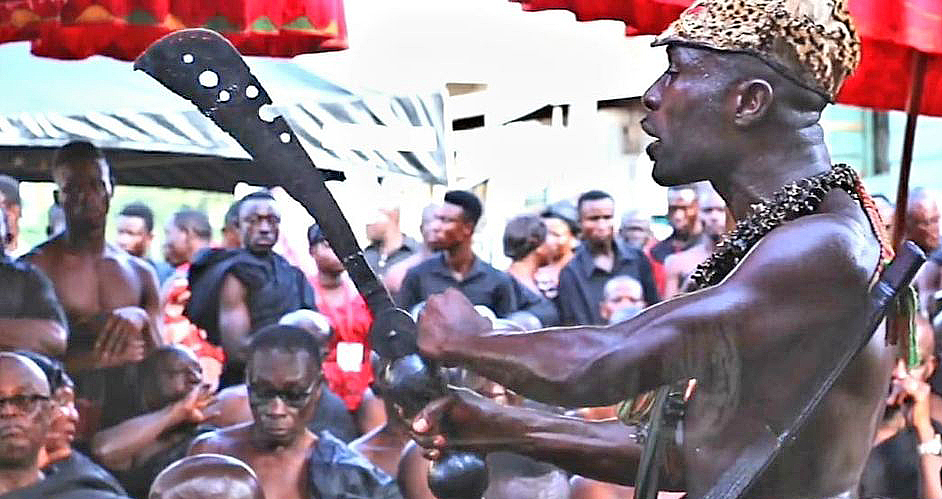Abrafoɔ generally refers to those who, in the olden days, constituted the constabulary and were responsible for law enforcement in the kingdom. These include Abrafoɔ (executioner and poets), Tɔprɛfoɔ, and Animosum.
The Abrafoɔ and Tɔprɛfoɔ were, in the past, responsible for carrying out executions and other forms of punishment for criminal offenders and in some cases, war captives. In current terminology, we may consider the Animosum (also known as anadwosekan or night knife in English) as commandos or more accurately, special forces. While it is the duty of Asekanfo (lit. knife bearers) to protect the Asantehemaa, they are not, technically speaking, regarded as Abrafoɔ.
The Asekanfo are from the area in downtown Kumase called Adum which is a corruption of Anum the Guan town in southeastern Ghana. The Adumfoɔ (Anumfoɔ) were special men who were assigned to protect and guard Ɔpemsoɔ Osei Tutu on his way from Akwamu to Kumase (kwaman) to be enstooled as Chief of Kumase (kwaman) . The Abrafoɔ, Tɔprɛfoɔ, and Animosum however perform a variety of duties related to the Asantehene or Sikadwa Kofi depending on the ceremony and it is fair to say that they are associated with the Asantehene.
The first group, Abrafoɔ are those who recite apae (appellations poetry) when Otumfoɔ sits in state, or during purification rites in the nkonwafieso (stool room) when the black stools of past kings are brought out, or when sikadwa is in a procession or during funerary rites. There are four independent groups with their respective chiefs.
Description of dress:
The combination of print cloth and a leopard’s hat as a dress began in recent momory and can be dated from early in the twentieth century when print cloths were introduced to the Asante Kingdom. The main dress of the Abrafoɔ was made entirely of the leopard’s skin that they wrap around their body and a leopard hat known as etwiekyɛ (leopard’s hat). Some of the hats have two eyes painted red on the forehead while others, especially the individual chiefs, have the leopard’s ear with sika nsɛbɛ (gold talismans) and leather talismans fixed on it.
Necklaces:
All the chiefs have some type of necklace. For instance, Nkram Abrafoɔ’s necklace is nipa akyi nkasɛe (dry bones of a spinal chord). The two necklaces worn by the Anoo Abrafoɔhene are dadie kɔnsɔnkɔnsɔn (metal chain) and nkɔnsɔn dadeɛ.
The former is originally made of pure gold that replaced sɛpɔhoma (made from a vine). Due to its weight, it was used as a weapon in the past by striking the head of an enemy with it. On the other hand, the nkɔnsɔn was used as a grip around the throat to prevent a condemned person from cursing the executioners. For Tweneduroase Abrafoɔhene, his necklace is made of kɔɔbre (copper). It is notewhorthy that all the swords and necklaces of Abrafoɔ are black due to contact with human blood in the past several centuries.
Swords:
Unlike kɛtɛanomfena, abrafoɔ swords do not have abɔsodeɛ and as a result, they hold the hilt while the sword blades are not in sheaths but exposed. The Nkram Abrafoɔhene’s sword is called kontonkronwi (refers to the hair around the neck). The Akan saying is that death is like the hair around the human neck, we all have it. That is, we shall all succumb to death one day. Anoo Abrafoɔhene’s sword is called, gye me di (trust me). Additionally, they all carry sɛpɔ (knives) in bɔha (leather sheaths) that they keep in the cloth but close to the chest. The four sɛpɔ knives on the Nkram Abrafoɔhene have unique names: kumamani (lit. killer of known persons/townsmen), kumahɔhoɔ (killer of visitors), kumadehyeɛ (killer of royals), and sɛpɔ (knife).
Format of reciting apae:
As stated above, this group of Abrafoɔ have an additional and a special duty of reciting heroic poetry (Apae). Although it is generally regarded as mmrane (praise poetry), Apae engages historical narratives by recounting past wars while the mpebi ne nkrawiri drums punctuate the cadences or sometimes overlap the voice. When the Asantehene sits in state either for a celebration, a funeral, or during the Akwasidae, the four chiefs will first take turns to recite apae and then step back to allow their children to also take turns to recite. When reciting, they lift the sword in the right hand, make a fist with the left hand and place the fisted left hand on the back of the sword, and while facing the Asantehene, they recite apae.
Reciting apae is random and depends on how the spirit moves the Abrafoɔ to the extent that sometimes one person can recite two or even three apae back to back before yielding to the next person in line.
While their children are reciting, all four chiefs will be on their feet and ready to step… in the likelihood that they blank out or forget a line. When that happens, that particular child will fall back immediately to regain his composure before rejoining the Abrafoɔ.
Source: Ashantibiz
Submit your stories or articles to us via WhatsApp +233-245092915




